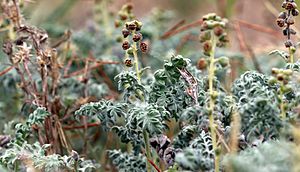San Diego ragweed facts for kids
Quick facts for kids San Diego ragweed |
|
|---|---|
 |
|
| Conservation status | |
| Scientific classification | |
| Genus: |
Ambrosia
|
| Species: |
pumila
|
| Synonyms | |
|
Franseria pumila Nutt. |
|
Ambrosia pumila is a very rare plant often called San Diego ragweed or San Diego ambrosia. It is a type of herb that lives for many years. This plant naturally grows in southern California and parts of Baja California, Mexico. You can find it in floodplains and open grasslands near wetland areas.
Where Does This Plant Live?
This plant can live in dry places. But it prefers the edges of floodplains. It also likes areas near vernal pools or similar wet spots. The San Diego ambrosia needs open areas and does not grow well in heavy shade.
Today, only 19 groups of these plants are known to exist. Fourteen of these groups are in San Diego County. Two more are in Riverside County. The last three groups are found in Baja California and Baja California Sur in Mexico. Sadly, many of the places where this plant used to grow are now covered by cities and buildings. Farming also threatens its habitat. Because it is so rare, this plant is listed as an endangered species in the United States.
What Does San Diego Ambrosia Look Like?
Ambrosia pumila is a fuzzy plant that grows from year to year. It usually reaches less than 0.5 metres (1.6 ft) (about 1.6 feet) tall. Its leaves are gray-green and feel soft and fuzzy. Each leaf is divided into many smaller parts. The leaves can be up to 13 centimeters (about 5 inches) long. They have special stems called petioles that look like wings.
The plant's flower cluster has male flower heads at the top. Below these are several larger female flower heads. Each female head usually makes one fruit. This fruit is a fuzzy burr that is only a few millimeters wide. It has short, soft spines. This plant rarely makes seeds. Instead, it mostly grows new plants from its long, underground stems called rhizomes. This way of growing is called vegetative reproduction.
How Is This Plant Protected?
Special areas were set aside in 2010 to protect this plant. These areas are called "critical habitat." They are important for the plant's survival. Some protected areas are in the cities of Temecula and Oceanside. You can also find them near Fallbrook and Lake Hodges. Other protected spots are inside Mission Trails Regional Park and the San Diego National Wildlife Refuge.
One big problem for the San Diego ambrosia is non-native weeds. These weeds grow very tall and block the sunlight from the smaller ambrosia plants. It is hard to remove these thick weed patches without hurting the rare ambrosia plants.


